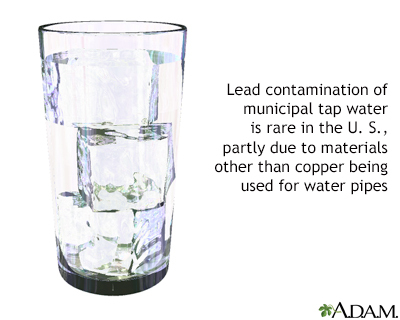Lead and tap water
Alternative Names
Water contaminated with lead
Information
The Safe Drinking Water Act requires the Environmental Protection Agency (EPA) to set and enforce standards to protect public drinking water systems. In the United States, the amount of lead in drinking water should be below 15 parts per billion.
The EPA requires all water suppliers to produce a water quality report every year. These reports include information about lead amounts. The reports are available to the public.
The EPA requires public water systems to alert you if there is a problem with your drinking water.
Lead can enter drinking water when plumbing materials that contain lead corrode. Corrosion is when metal is dissolved or worn away by a chemical reaction between water and your plumbing. Water that has high acidity or low mineral content can corrode pipes and fixtures.
The most common sources of lead in drinking water are lead pipes, faucets, and fixtures. Service lines connect the home to the water main. In homes with lead service lines, these pipes are the main source of lead in the water. Lead pipes are more likely to be found in homes built before 1986. In homes without lead service lines, plumbing with lead solder can be a source of lead in the water.
How much lead enters the water depends on:
- The chemistry of the water and the types and amounts of minerals in the water
- The amount of lead the water comes into contact with
- The temperature of the water
- The amount of wear in the pipes
- How long the water stays in pipes
- The presence of protective scales or coatings inside the plumbing materials
For more information, call:
- EPA's Safe Drinking Water Hotline (800-426-4791)
- National Lead Information Center ( 800-424-5323)
Gallery

References
United States Environmental Protection Agency website. Basic information about lead in drinking water. www.epa.gov/ground-water-and-drinking-water/basic-information-about-lead-drinking-water. Updated December 16, 2021. Accessed January 18, 2022.